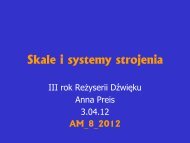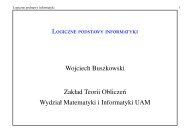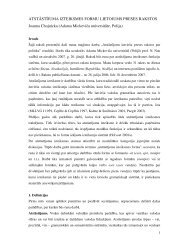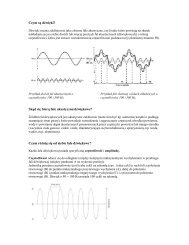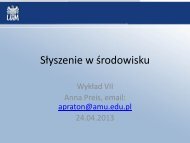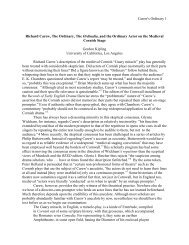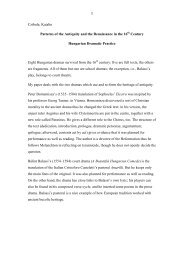Amir Weiner Getting to Know You
Amir Weiner Getting to Know You
Amir Weiner Getting to Know You
Create successful ePaper yourself
Turn your PDF publications into a flip-book with our unique Google optimized e-Paper software.
42 AMIR WEINER AND AIGI RAHI-TAMM<br />
intelligence, its investiga<strong>to</strong>rs reconstructed the events and quickly apprehended<br />
the leading instiga<strong>to</strong>rs of the riots. The agency chose not <strong>to</strong> prosecute several<br />
students who had been caught a few days earlier writing pro-Hungarian<br />
graffiti and limited itself <strong>to</strong> “prophylactic” measures since the students were<br />
of “our social origins”—that is, workers. Instead, it recommended that they<br />
be expelled from the university and drafted in<strong>to</strong> the army as a deterrence<br />
<strong>to</strong> other potential offenders. The response <strong>to</strong> the mass outbreaks three days<br />
later was equally restrained. Except for four individuals who were arrested<br />
and sentenced, the rest of the 85 detainees were questioned, warned, and<br />
released. 119 Restraint spelled confidence, and for a reason. By that time, the<br />
KGB was already in full transition <strong>to</strong> a new era.<br />
With a new leadership that displayed confidence in local cadres and<br />
the population, as well as in the ability of the system <strong>to</strong> absorb shocks—the<br />
very features absent from Stalin’s world—reforms were underway. Further<br />
compilation and use of the special card index was ruled unnecessary, and<br />
sometime later it was s<strong>to</strong>red in a remote location in Siberia. 120 The security<br />
forces moved <strong>to</strong> enforce widespread communal policing on the restless western<br />
frontier via public trials, street patrols, and an active constituency of war<br />
veterans that yielded more information on its population than ever before.<br />
With the armed opposition crushed, the embryonic dissident movement<br />
offered nothing the security services could not handle. This, however, was<br />
only half of the s<strong>to</strong>ry. With mass terror out, the regime faced two major<br />
challenges of its own making. Mass terror was the only viable <strong>to</strong>ol <strong>to</strong> keep<br />
in check the growing and unbridgeable gap between the u<strong>to</strong>pian claims and<br />
the dreary reality of socialism in power. The question now arose: how long<br />
could the Stalinist formula of vast operational knowledge and little social<br />
understanding be sustained, especially with incomprehensible and restless<br />
youth, a rising middle class, and increasing exposure <strong>to</strong> a wealthier outside<br />
world via <strong>to</strong>urism, radio and television broadcasts, and cultural exchanges—<br />
in short, the very things that the Soviet Union struggled <strong>to</strong> either fathom or<br />
contain.<br />
A final word concerns the relations between the Soviet surveillance<br />
system and the Soviet enterprise as a whole, a perspective that highlights<br />
that system’s relatively impressive record in infiltrating alien constituencies,<br />
especially when compared with the intelligence services of other polities.<br />
Imposing their rule on foreign populations, European empires, such as the<br />
British and the French, developed vast systems of study and control with<br />
119 LYA f. K-1, ap. 3, b. 509, ll. 178, 245.<br />
120 Kopylova, ‘‘V poiskakh ‘spetskar<strong>to</strong>tetki GAU NKVD SSSR,’ ’’ 31– 37.



